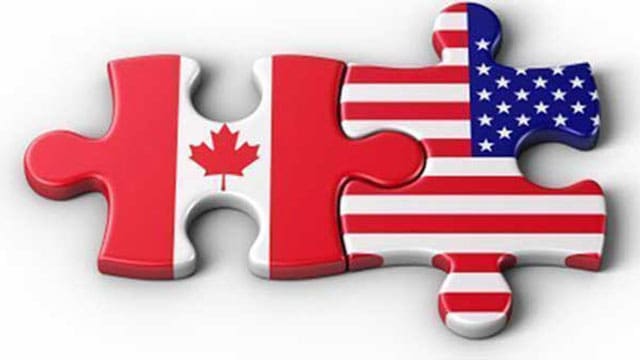How Canada can preserve its sovereignty while deepening cross-border co-operation

For interview requests, click here
Robert Frost famously said, “Good fences make good neighbours.” While this adage underscores the importance of respecting boundaries, it also invites reflection on the purpose of those fences and how they shape relationships. For Canada and the United States, the border symbolizes both division and a shared history—a line of sovereignty and a bridge of interdependence.
At a time of significant global challenges, it’s essential to re-examine this relationship, address its strengths and vulnerabilities, and lay the groundwork for a stronger partnership.
As someone deeply connected to both nations, this topic is profoundly personal. Born and raised in the U.S., I moved to Canada as a young man and eventually became a Canadian citizen. This choice reflected years of experience and admiration for Canada’s distinct identity and values. It also mirrored a recognition of the deep, sometimes fraught, interdependence between the two nations—a relationship rooted in history and shared interests yet continually tested by evolving challenges.
 Good fences make good neighbours, but great partnerships build futures. |
| Recommended |
| The Trump bust will hit small towns the hardest – and they’re not ready
|
| As Trump looms, Canada will be tested as never before
|
| Canada’s leadership vacuum fueling a national crisis
|
Canada and the United States share the longest undefended border in the world, a testament to a partnership built on trust and mutual benefit. Economically, culturally, and politically, the ties run deep. Alberta’s energy exports to the U.S., for example, fuel both economies but also reveal the risks of overdependence on a single market. Similarly, the U.S. reliance on Canadian resources—from oil and gas to timber and wheat—highlights a reciprocal need that must be carefully managed.
Yet this interdependence is not without tension. Divergent values and policy approaches often create friction. Canada takes pride in its emphasis on social welfare, multiculturalism, and collective well-being. The U.S., on the other hand, is known for its individualism, market-driven dynamism, and global assertiveness. While sometimes a source of misunderstanding, these differences also offer valuable lessons for each nation.
In an increasingly interconnected world, the challenges facing Canada and the U.S. transcend borders. Environmental and economic transitions, technological disruptions, and geopolitical uncertainty demand a unified approach. For instance, given the cross-border nature of environmental impacts, the shift toward renewable energy and climate adaptation requires co-ordinated policies. Similarly, addressing technological changes, such as the regulation of artificial intelligence and securing supply chains, necessitates collaboration.
However, this partnership must not come at the expense of Canada’s unique identity and sovereignty. Troubling rhetoric, like Donald Trump’s suggestion to annex Canada into a “United States of North America,” highlights the need for vigilance. While such remarks may lack immediate credibility, they remind us of the importance of preserving Canadian independence while fostering a respectful relationship.
To maintain a strong partnership, both nations must tackle key challenges together. Addressing these issues collaboratively will build trust and mutual prosperity. Here are some critical areas that demand attention:
- Supply chain management: Reform is needed to prevent inflated consumer prices and ensure industries adapt to market changes, promoting competition, innovation, and affordability.
- NATO responsibilities: Canada must be a committed funder, active partner, and strong defender within the alliance to uphold democracy and collective security.
- Restoring merit: The focus on “woke” ideologies has overshadowed the importance of qualifications, ability, and achievement. Merit must return as the primary standard for decision-making.
- Corruption: Corruption in Canadian government, particularly in procurement, must be eliminated. It requires zero tolerance at all levels and across all political parties to restore accountability.
- China’s influence: Undue interference in Canadian politics and elections threatens sovereignty and democracy. Immediate action is needed to eliminate this influence and protect political integrity.
- Sovereignty: Secure, well-protected borders are essential to maintaining Canada’s sovereignty and safety, fostering mutual respect and clear boundaries in international relations.
- Corporate subsidies: Subsidies and incentives should only be used in urgent situations, addressing critical needs without fostering dependency or creating unfair advantages.
- Standard of living: Economic productivity must translate into tangible improvements in citizens’ standard of living, ensuring growth benefits everyone.
- Energy transition: Canada must balance its global responsibilities in the energy transition while addressing the world’s ongoing demand for reliable energy resources.
- Border security: Strengthen measures to stop the flow of illegal guns into Canada and fentanyl into the U.S., ensuring the safety of both nations.
While these issues present significant challenges, they also offer opportunities for Canada and the U.S. to strengthen their partnership through focused, collaborative policies. Moving forward, both nations must formalize and deepen their dialogue, drawing on their shared history to confront modern challenges effectively.
A bilateral climate and energy council could align policies and accelerate the transition to sustainable practices. Similarly, joint task forces on emerging technologies, like artificial intelligence and cybersecurity, would foster innovation while protecting national interests. Modernizing trade agreements, like the United States-Mexico-Canada Agreement (USMCA), could address economic vulnerabilities and reflect current realities. Finally, expanding cultural exchange programs—including student exchanges and cross-border internships—would deepen grassroots connections and mutual understanding.
Canada and the U.S. have always been more than neighbours—they are partners bound by geography, history, and shared destiny. However, this partnership must evolve to meet the demands of the future. By prioritizing collaboration on critical issues and respecting each other’s sovereignty, both nations can chart a course toward greater prosperity and stability.
The challenges we face—environmental, technological, and geopolitical—demand co-operation, not isolation. Let’s work together not to erase our differences but to build a shared future rooted in mutual respect and purpose.
Good fences may make good neighbours, but great partnerships make better futures.
Dr. Perry Kinkaide is a visionary leader and change agent. Since retiring in 2001, he has served as an advisor and director for various organizations and founded the Alberta Council of Technologies Society in 2005. Previously, he held leadership roles at KPMG Consulting and the Alberta Government. He holds a BA from Colgate University and an MSc and PhD in Brain Research from the University of Alberta.
Explore more on Canada-U.S. relations, Donald Trump, Trade, Energy transition
Troy Media is committed to empowering Canadian community news outlets by providing independent, insightful analysis and commentary. Our mission is to support local media in building an informed and engaged public by delivering reliable content that strengthens community connections, enriches national conversations, and helps Canadians learn from and understand each other better.
